A Dual Constant Current Output Ports WPT System Based on Integrated Coil Decoupling: Analysis, Design, and Verification
Abstract
:1. Introduction
2. Theoretical Analysis of Transmitter Side Decoupling Coil Magnetic Coupler
3. Theoretical Analysis
4. Simulation Experiment Verification
5. Experimental Verification
5.1. Experimental Prototype
5.2. Experimental Results
6. Conclusions
Author Contributions
Funding
Data Availability Statement
Conflicts of Interest
References
- Li, Y.; Mai, R.; Liu, Y.; He, Z. Efficiency optimising strategy for dual-coupled transmitters based WPT systems. Electron. Lett. 2016, 52, 1877–1879. [Google Scholar] [CrossRef]
- Li, Y.; Hu, J.; Li, X.; Cheng, K.-W.-E. A Flexible Load-Independent Multi-Output Wireless Power Transfer System Based on Cascaded Double T-Resonant Circuits: Analysis, Design and Experimental Verification. IEEE Trans. Circuits Syst. Regul. Pap. 2019, 66, 2803–2812. [Google Scholar] [CrossRef]
- Lillholm, M.-B.; Dou, Y.; Chen, X.; Zhang, Z. Analysis and Design of 10-MHz Capacitive Power Transfer With Multiple Independent Outputs for Low-Power Portable Devices. IEEE J. Emerg. Sel. Top. Power Electron. 2022, 10, 149–159. [Google Scholar] [CrossRef]
- Cai, C.; Saeedifard, M.; Wang, J.; Zhang, P.; Zhao, J.; Hong, Y. A Cost-Effective Segmented Dynamic Wireless Charging System With Stable Efficiency and Output Power. IEEE Trans. Power Electron. 2022, 37, 8682–8700. [Google Scholar] [CrossRef]
- Jafari, H.; Moghaddami, M.; Olowu, T.-O.; Sarwat, A.-I.; Mahmoudi, M. Virtual Inertia-Based Multipower Level Controller for Inductive Electric Vehicle Charging Systems. IEEE J. Emerg. Sel. Top. Power Electron. 2021, 9, 7369–7382. [Google Scholar] [CrossRef]
- Cai, C.; Wang, J.; Wan, L.; Wang, C. Optical Fiber Composite Winding for In Situ Thermal Monitoring of Transmitter Magnetic Mechanism in Long-Track DWPT Systems. IEEE Trans. Instrum. Meas. 2024, 73, 1–4. [Google Scholar] [CrossRef]
- Pahlavan, S.; Ashtiani, S.-J.; Saad, M.; Soon, T.-K.; Chong, W.-T. Rotation-Tolerant Wireless Power Transmission Scheme with Smart Positioning for Cognitive Research on Moving Animals. IEEE Trans. Biomed. Circuits Syst. 2024, 18, 123–130. [Google Scholar] [CrossRef]
- Pahlavan, S.; Shooshtari, M.; Ashtiani, S.-J. Star-Shaped Coils in the Transmitter Array for Receiver Rotation Tolerance in Free-Moving Wireless Power Transfer Applications Energies. Energies 2022, 15, 8643. [Google Scholar] [CrossRef]
- Zhou, R.; Chung, H.; Zhang, R. An inductive power transfer system for driving multiple OLED light panels. IEEE Trans. Power Electron. 2016, 31, 7131–7147. [Google Scholar] [CrossRef]
- Stankiewicz, J.-M. Analysis of the Wireless Power Transfer System Using a Finite Grid of Planar Circular Coils Energies. Energies 2023, 16, 7651. [Google Scholar] [CrossRef]
- Vu, V.-B.; Phan, V.-T.; Nguyen, D.-T.; Logenthiran, T.; Naayagi, R.-T. Design and implementation of a multi-output inductive charger for electric vehicles. In Proceedings of the 2016 IEEE International Conference on Sustainable Energy Technologies, Hanoi, Vietnam, 14–16 November 2016; pp. 414–419. [Google Scholar]
- Yang, C.; Li, M.; Yang, B.; Chen, S.; Li, Q.; He, Z.; Mai, R. Variable-Parameter T-Circuit-Based IPT System Charging Battery With Constant Current or Constant Voltage Output. IEEE Trans. Power Electron. 2019, 35, 1672–1684. [Google Scholar]
- Jang, Y.; Jovanovic, M.-M. A Contactless Electrical Energy Transmission System for Portable-telephone Battery Chargers. IEEE Trans. Ind. Electron. 2003, 31, 520–527. [Google Scholar] [CrossRef]
- Hu, J.; Lu, F.; Zhu, C.; Cheng, C.Y.; Chen, S.L.; Ren, T.J.; Mi, C.C. Hybrid Energy Storage System of an Electric Scooter Based on Wireless Power Transfer. IEEE Trans. Ind. Inform. 2018, 14, 4169–4178. [Google Scholar] [CrossRef]
- McDonough, M. Integration of Inductively Coupled Power Transfer and Hybrid Energy Storage System: A Multiport Power Electronics Interface for Battery-Powered Electric Vehicles. IEEE Trans. Power Electron. 2015, 30, 6423–6433. [Google Scholar] [CrossRef]
- Yu, K.-O.; Jossel Mindoro Maestro, R.; De Leon, M.-T.-G. A Study on the Effectiveness of Using a Hybrid Topology in Improving the Power Efficiency and Voltage Regulation over a Wide Input Range of DC-DC Converters. In Proceedings of the TENCON 2018–2018 IEEE Region 10 Conference, Jeju, Republic of Korea, 28–31 October 2018; pp. 2104–2109. [Google Scholar]
- Li, Y.; Hu, J.; Chan, K.W.; Eric Cheng, K.-W.; Liu, M. A Flexible Load-Independent Multi-Output Wireless Power Transfer System Based on Double-T Resonant Circuit Technique. In Proceedings of the 2018 IEEE Energy Conversion Congress and Exposition (ECCE), Portland, OR, USA, 23–27 September 2018; pp. 3593–3596. [Google Scholar]
- Casanova, J.-J.; Low, Z.-N.; Lin, J. A Loosely Coupled Planar Wireless Power System for Multiple Receivers. IEEE Trans. Ind. Electron. 2009, 56, 3060–3068. [Google Scholar] [CrossRef]
- Cannon, B.-L.; Hoburg, J.F.; Stancil, D.D.; Goldstein, S.C. Magnetic Resonant Coupling As a Potential Means for Wireless Power Transfer to Multiple Small Receivers. IEEE Trans. Power Electron. 2009, 24, 1819–1825. [Google Scholar] [CrossRef]
- Liu, X.; Han, W.; Liu, C.; Pong, P. Marker-free coil-misalignment detection approach using TMR sensor array for dynamic wireless charging system of electric vehicles. IEEE Trans. Magn. 2018, 54, 4002305. [Google Scholar] [CrossRef]
- Zhang, J.; Yuan, X.; Wang, C.; He, Y. Comparative analysis of two-coil and three-coil structures for wireless power transfer. IEEE Trans. Power Electron. 2017, 32, 341–352. [Google Scholar] [CrossRef]
- Mai, R.; Luo, Y.; Yang, B.; Song, Y.; Liu, S.; He, Z. Decoupling circuit for automated guided vehicles IPT charging systems with dual receivers. IEEE Trans. Power Electron. 2020, 35, 6652–6657. [Google Scholar] [CrossRef]
- Wang, X.; Xu, J.; Ma, H.; Zhang, Y. A Reconstructed S-LCC Topology With Dual-Type Outputs for Inductive Power Transfer Systems. IEEE Trans. Power Electron. 2020, 35, 12606–12611. [Google Scholar] [CrossRef]
- Zhong, W.; Hui, S.Y.R. Auxiliary circuits for power flow control in multifrequency wireless power transfer systems with multiple receivers. IEEE Trans. Power Electron. 2015, 30, 5902–5910. [Google Scholar] [CrossRef]
- Zhang, Y.; Lu, T.; Zhao, Z.; He, F.; Chen, K.; Yuan, L. Selective wireless power transfer to multiple loads using receivers of different resonant frequencies. IEEE Trans. Power Electron. 2015, 30, 6001–6005. [Google Scholar] [CrossRef]
- Chen, W.; Li, H.; Lu, W. Decoupling design of multi-coil wireless power transfer system with metal insulator. In Proceedings of the 2017 IEEE PELS Workshop on Emerging Technologies: Wireless Power Transfer (WoW), Chongqing, China, 20–22 May 2017; pp. 30–33.
- Zhou, Z.; Shi, Q.; Cheng, C.; Li, W.; Deng, Z.; Li, F.; Mi, C. A Multi-load wireless power transfer system with constant voltage outputs using S-LCC compensation. In Proceedings of the 2019 22nd International Conference on Electrical Machines and Systems (ICEMS), Harbin, China, 11–14 August 2019; pp. 11–14. [Google Scholar]
- Wang, H.-S.; Cheng, K.-W.-E. Analysis, design, and validation of a decoupled double-receiver wireless power transfer system with constant voltage outputs for industrial power supplies. IEEE Trans. Ind. Informatics 2019, 19, 362–370. [Google Scholar] [CrossRef]
- Pang, H.; Chau, K.T.; Han, W.; Liu, W.; Zhang, Z. Decoupled-Double D Coils Based Dual-Resonating-Frequency Compensation Topology for Wireless Power Transfer. IEEE Trans. Magn. 2022, 58, 1–7. [Google Scholar] [CrossRef]
- Pratik, U.; Varghese, B.-J.; Azad, A.; Pantic, Z. Optimum Design of Decoupled Concentric Coils for Operation in Double-Receiver Wireless Power Transfer Systems. IEEE J. Emerg. Sel. Top. Power Electron. 2018, 7, 1982–1998. [Google Scholar] [CrossRef]
- Qu, X.; Chu, H.; Wong, S.-C.; Tse, C.-K. An IPT battery charger with near unity power factor and load-independent constant output combating design constraints of input voltage and transformer parameters. IEEE Trans. Power Electron. 2019, 34, 7719–7727. [Google Scholar] [CrossRef]
- Wang, J.; Sun, Q.; Li, Y. A CV-type WPT system based on CLC-N compensation with compact receiver. Int. J. Circuit Theory Appl. 2024. early access. [Google Scholar] [CrossRef]
- Yang, L.; Dong, K.; Wang, Y.; Cai, C.; Zhou, X. Analysis, Design, and Validation of a Dual-Channel High-Power WPT System Based on Bilateral Coil Decoupling. IEEE J. Emerg. Sel. Top. Power Electron. 2024, 12, 4288–4295. [Google Scholar] [CrossRef]
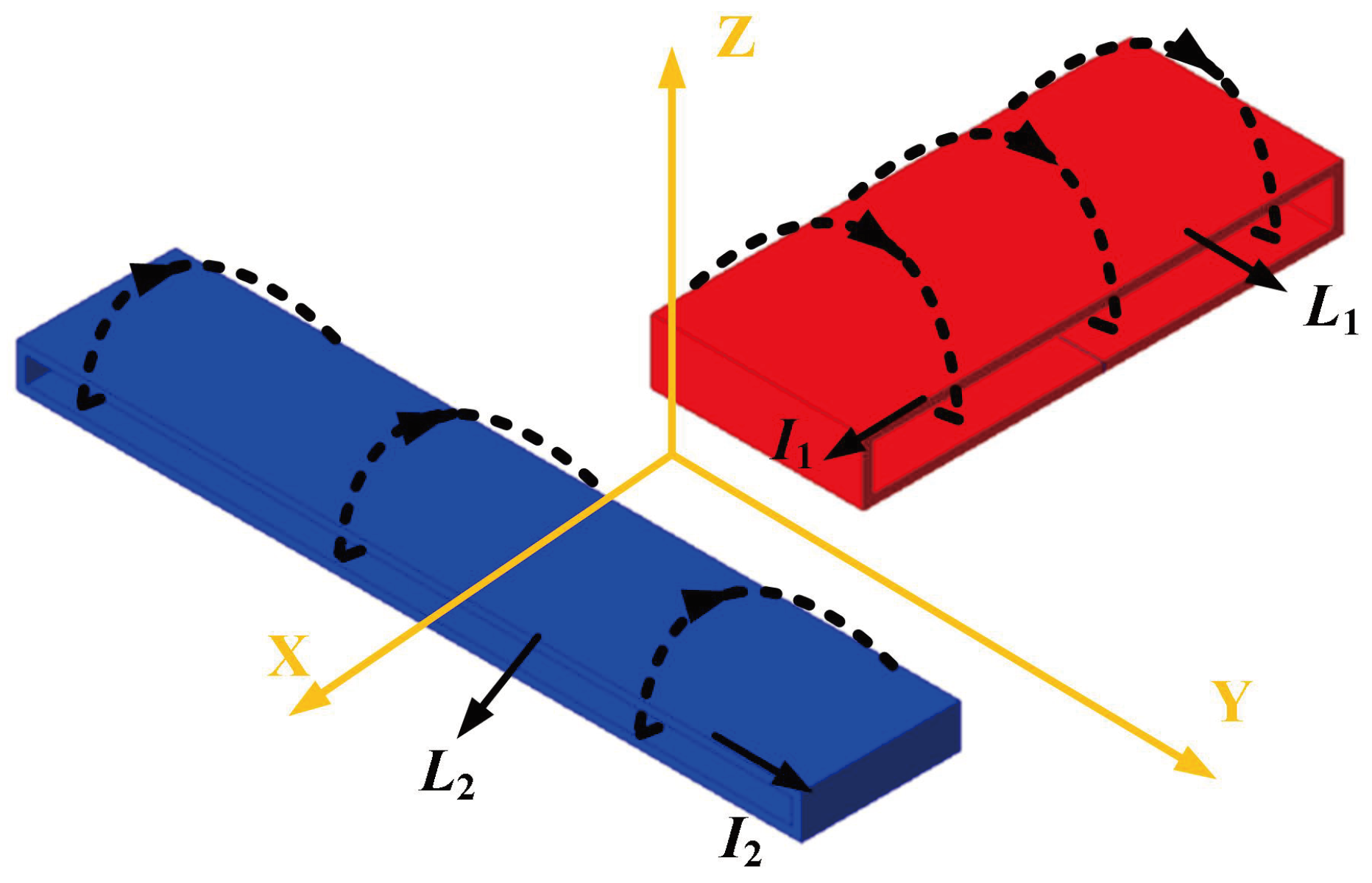
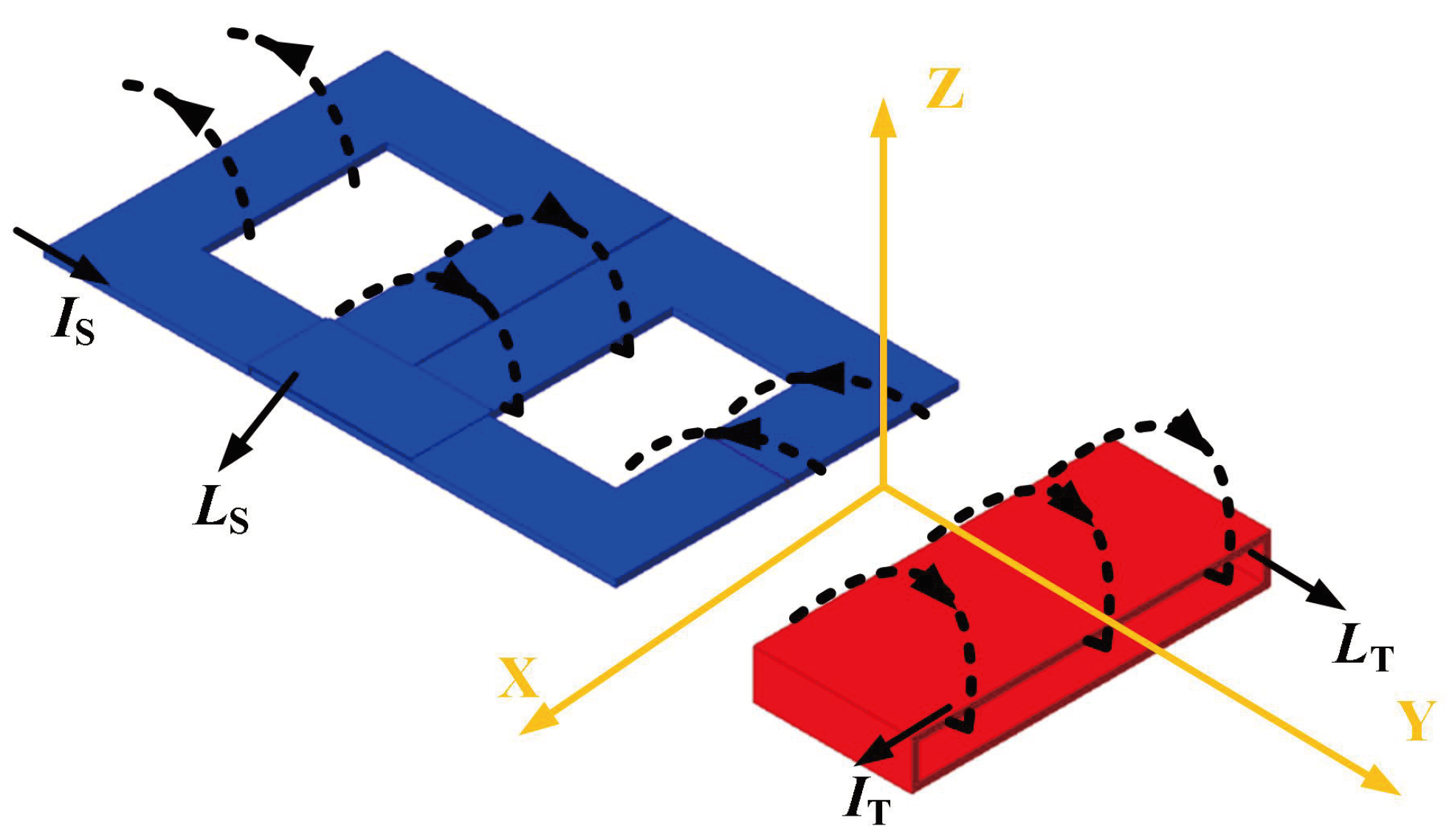

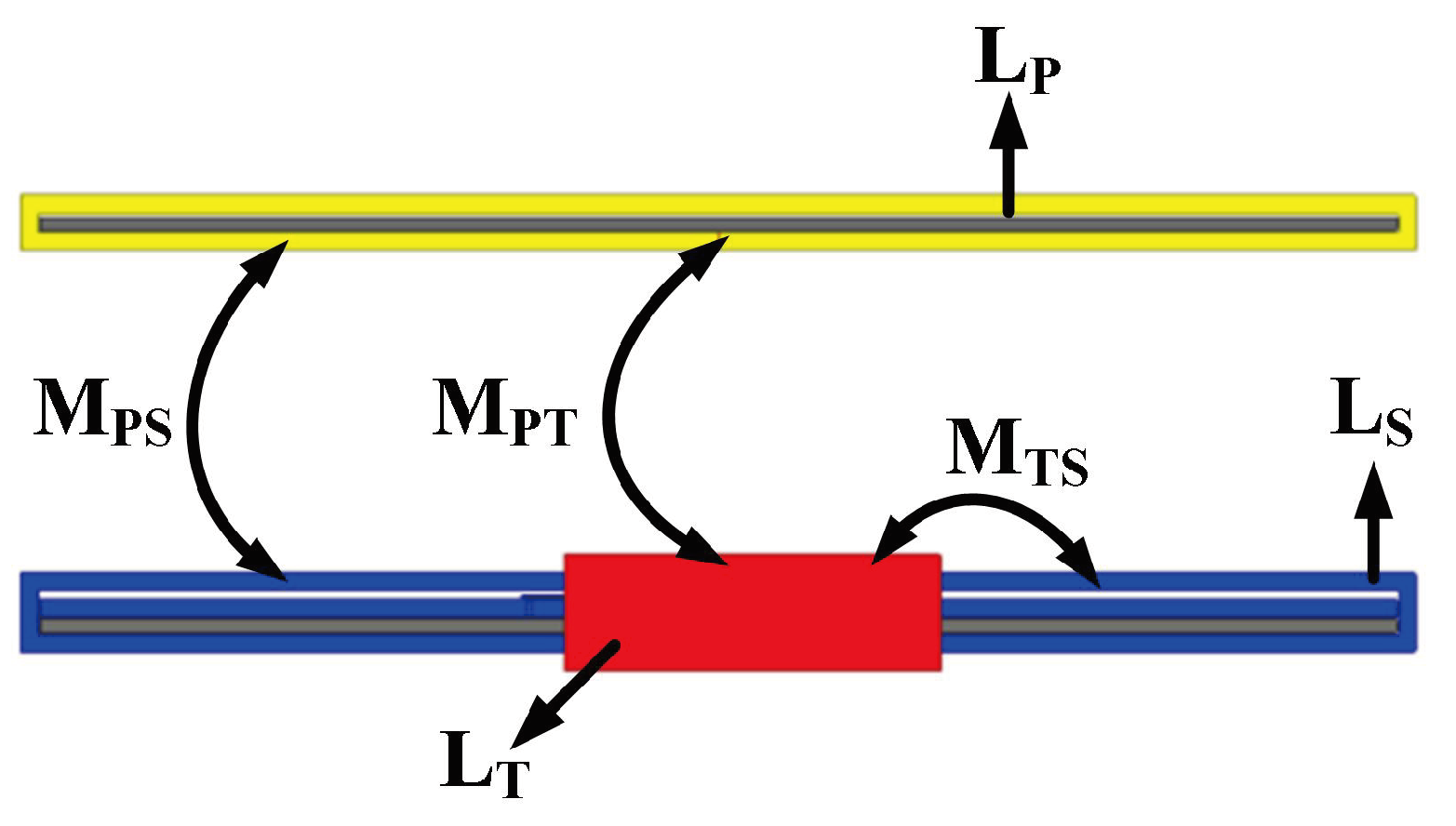
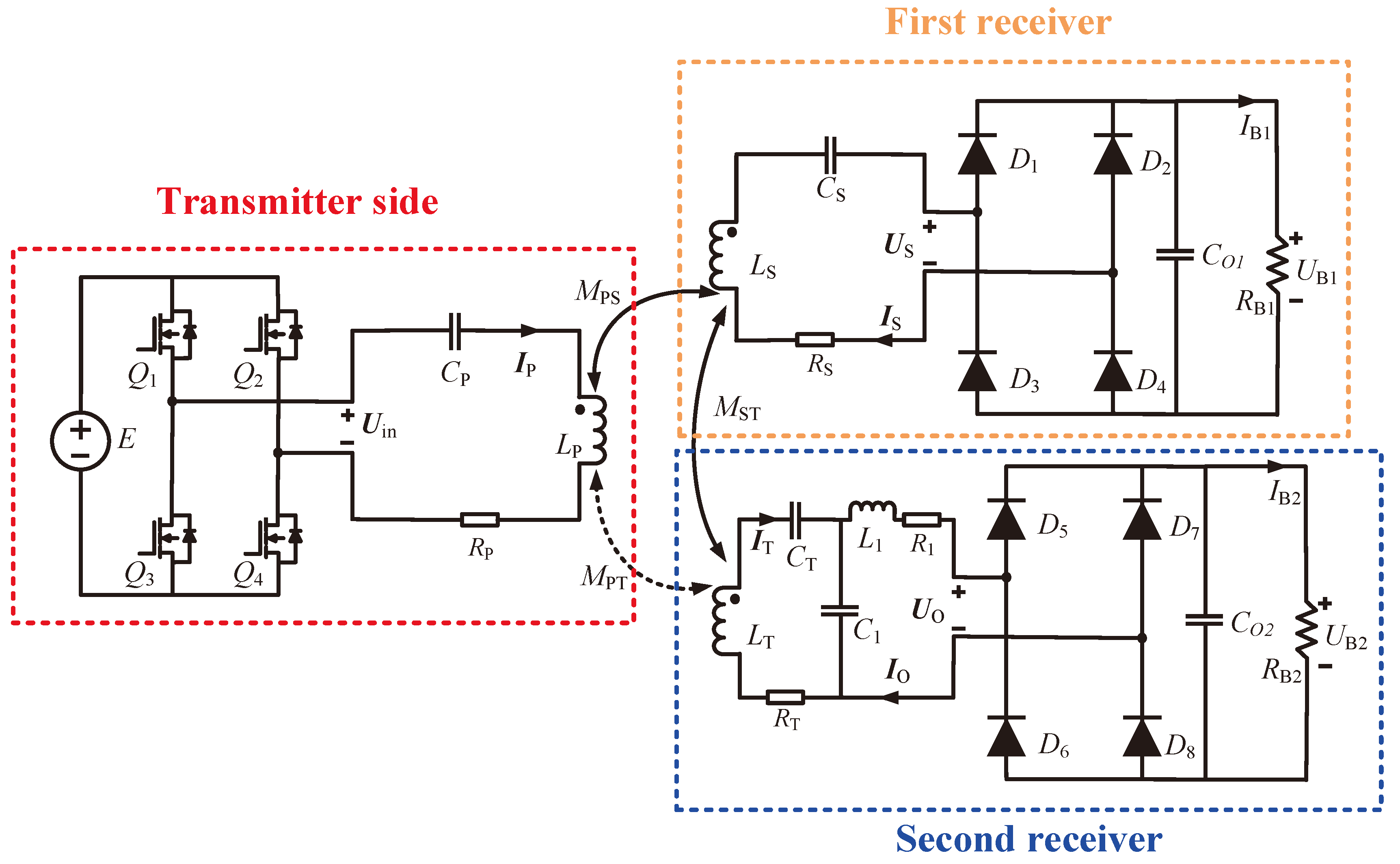

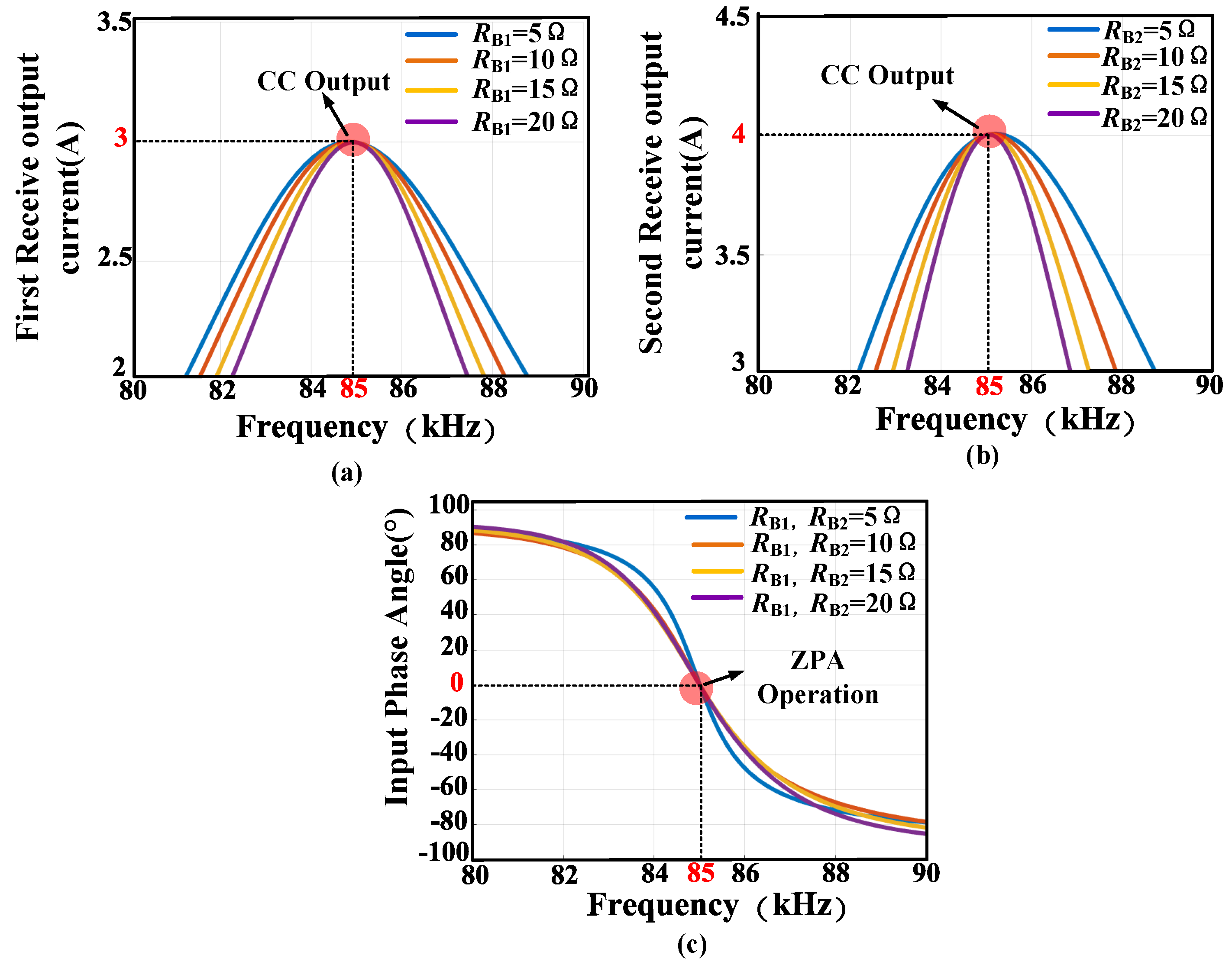



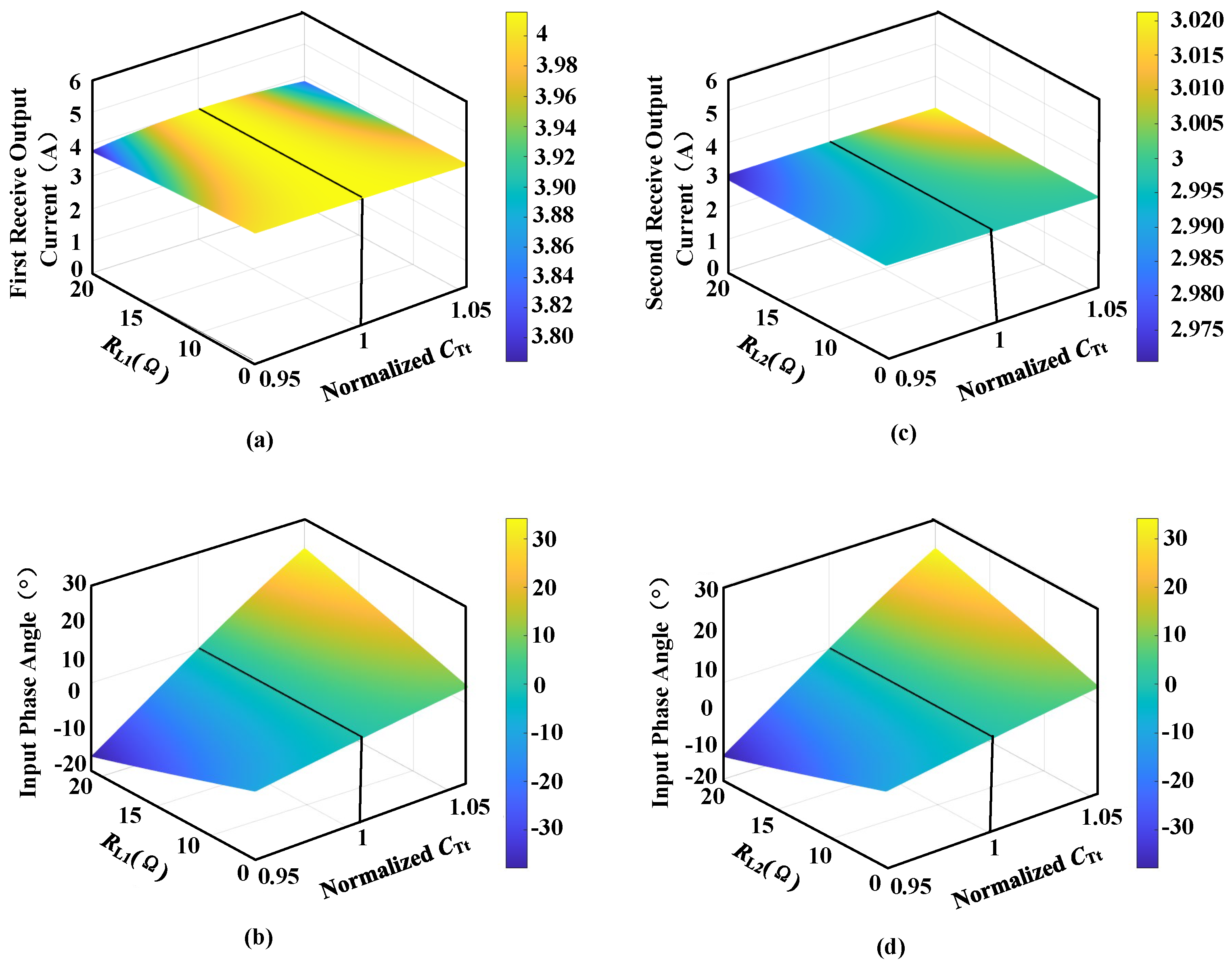
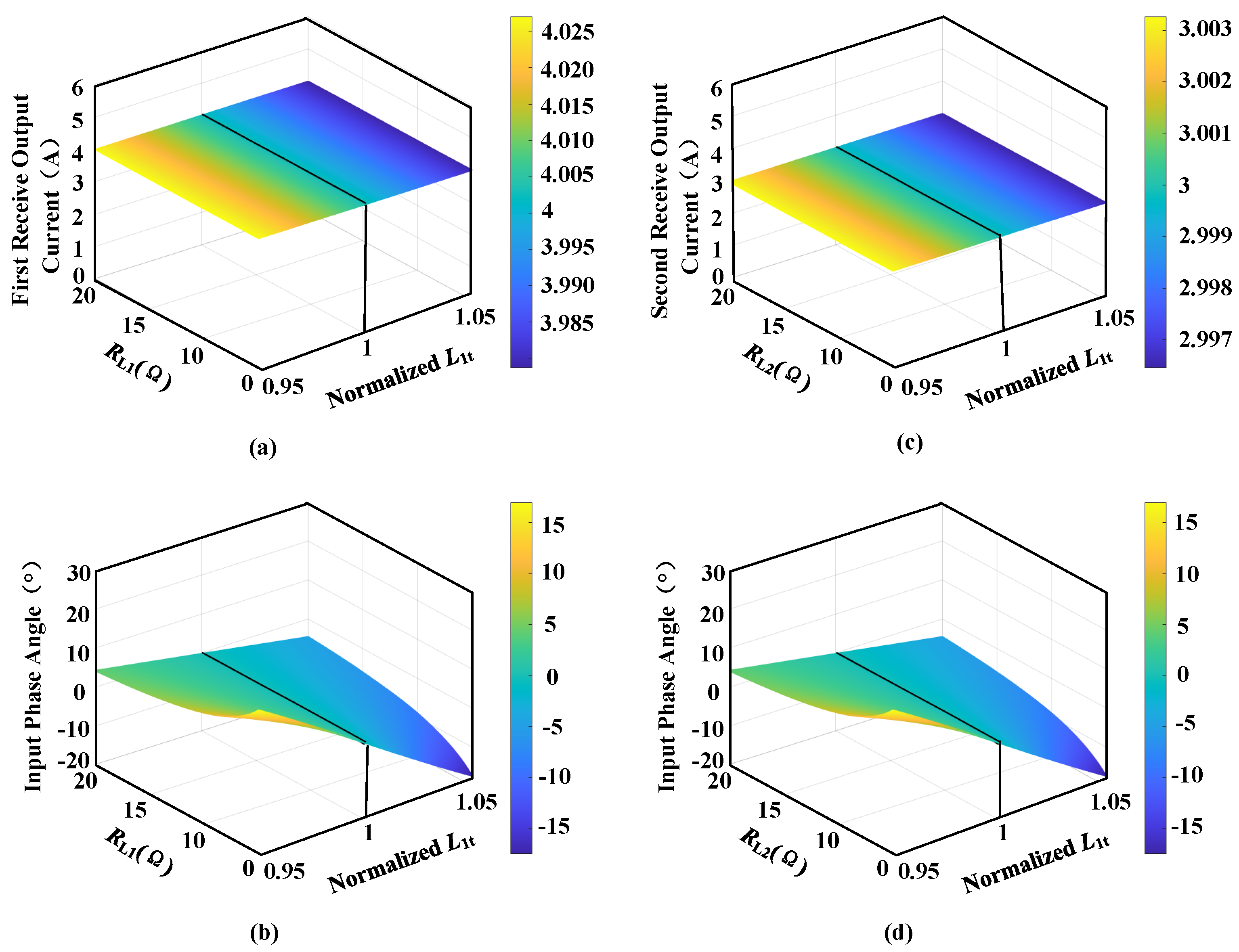
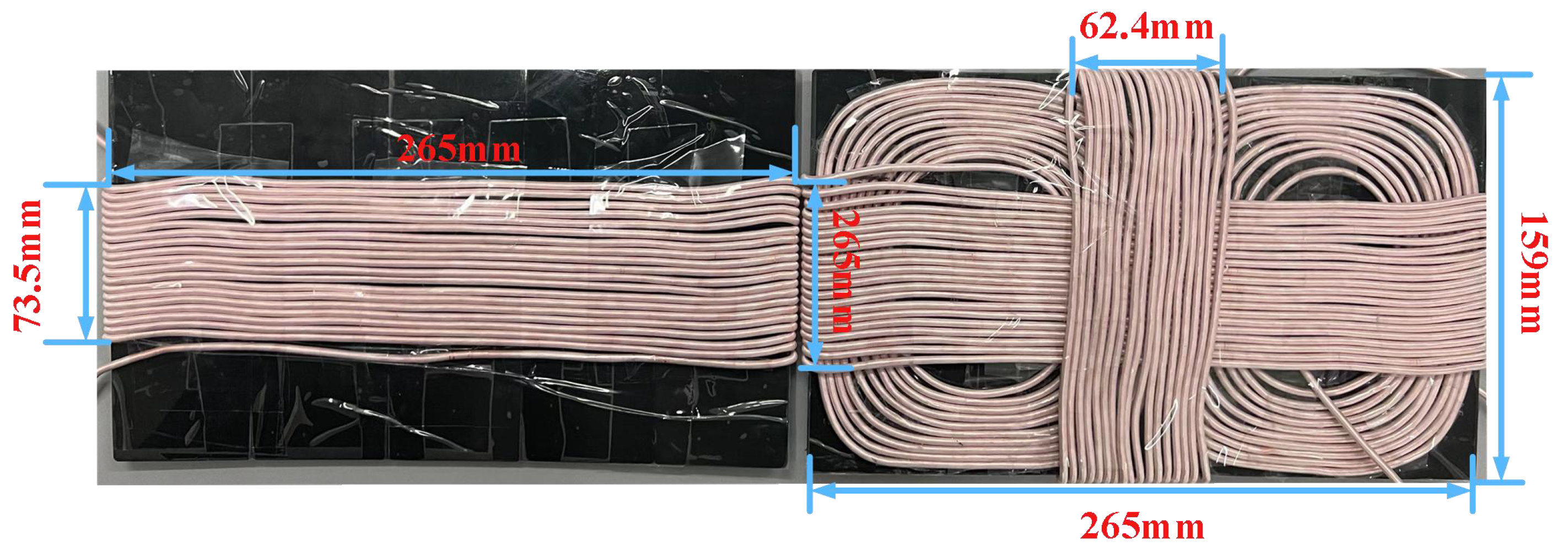
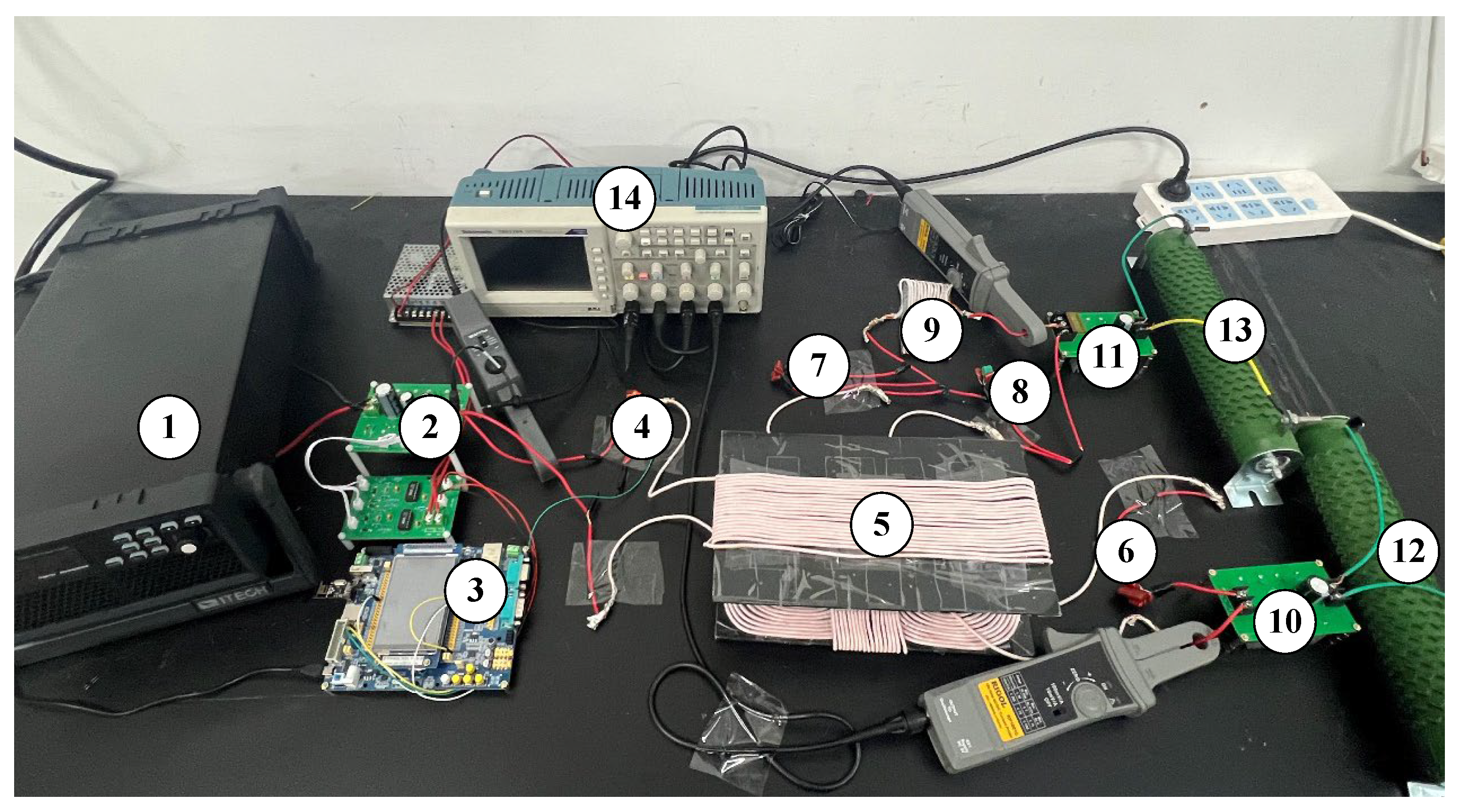


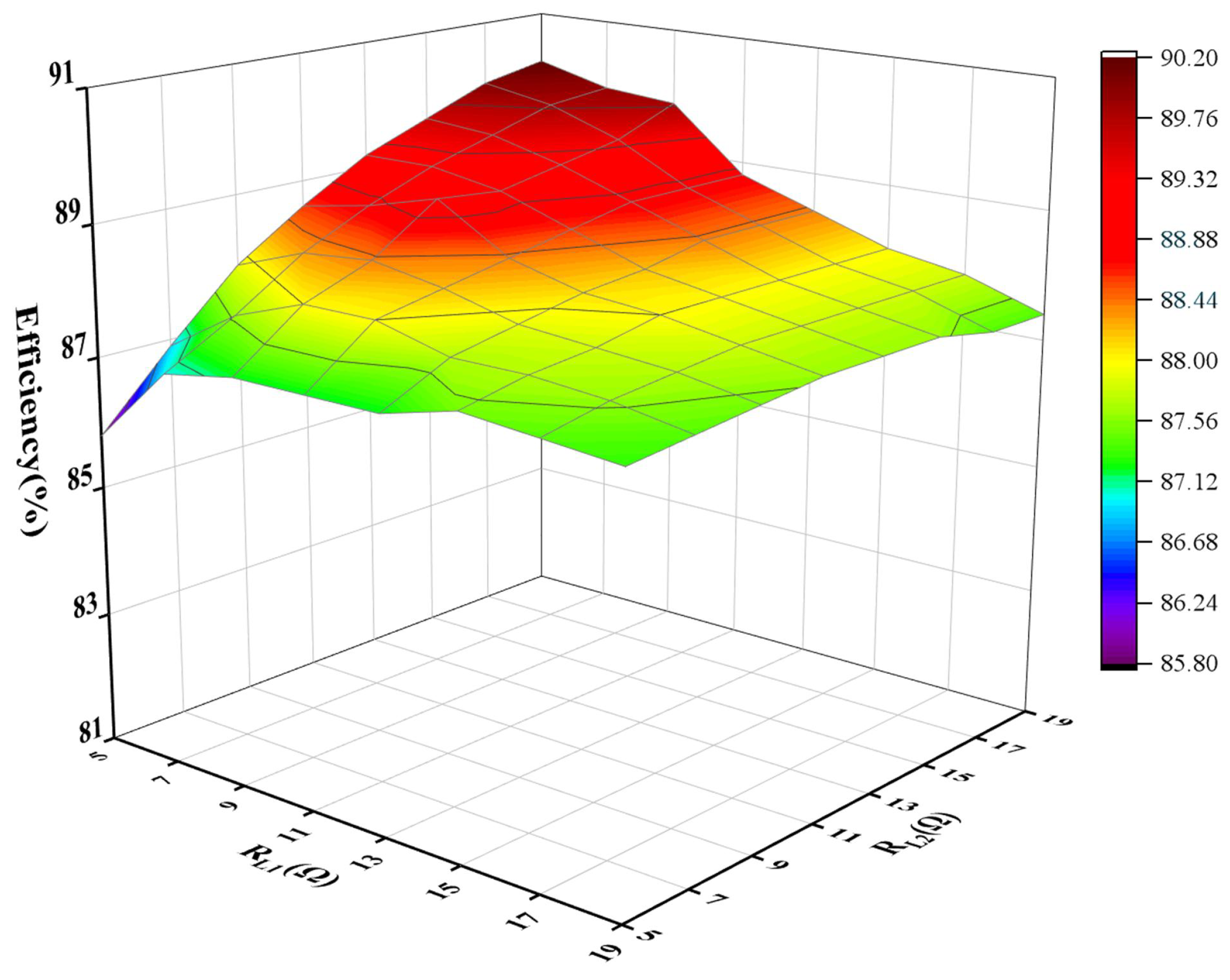
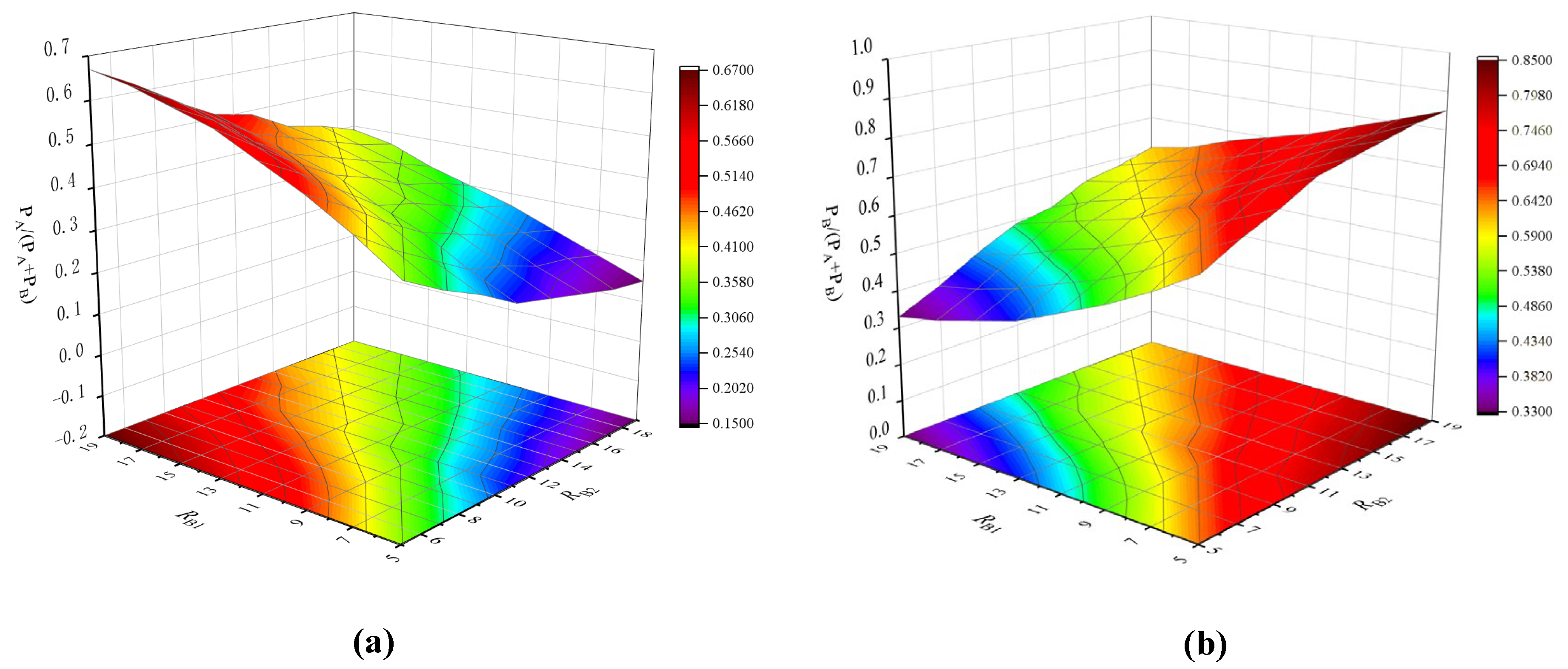
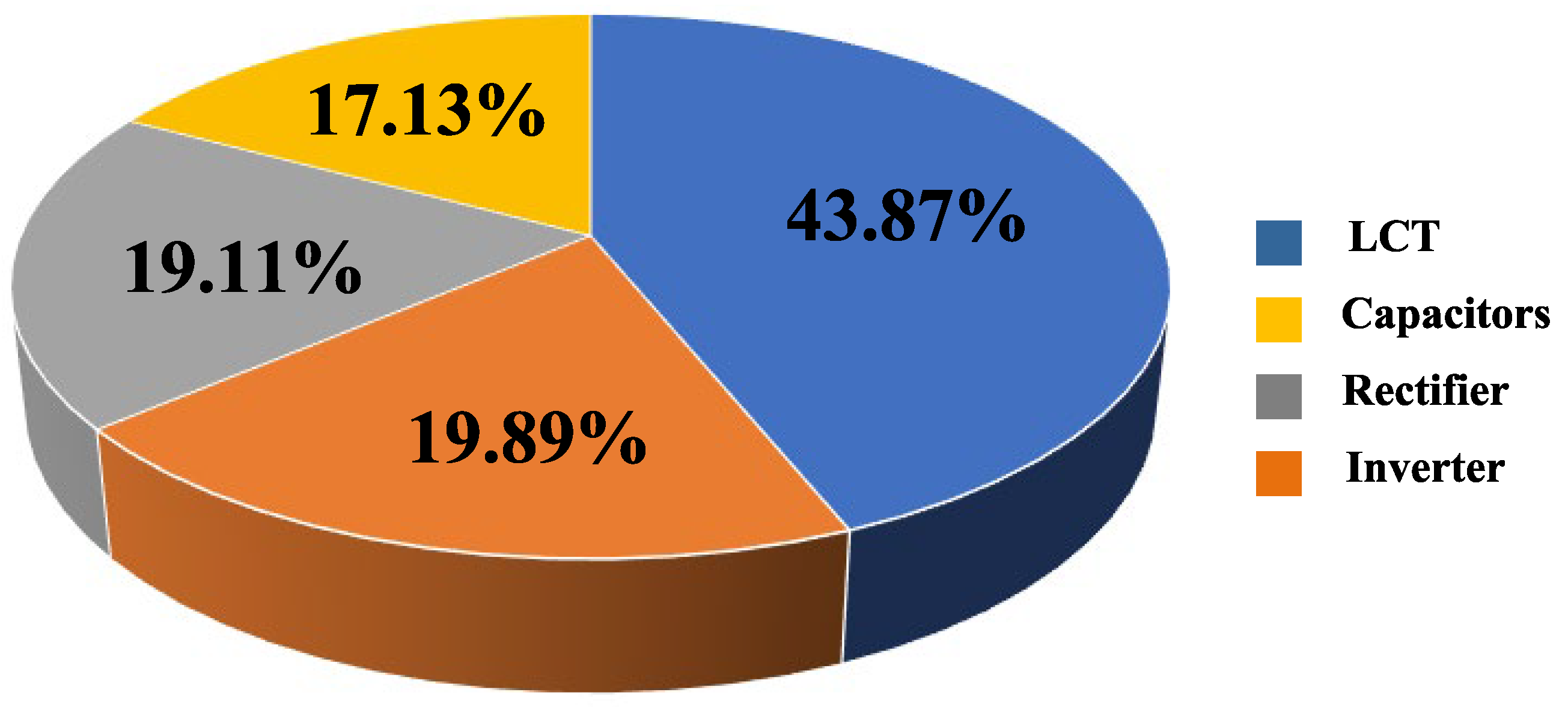
| Parameters | Value | Parameters | Value |
|---|---|---|---|
| f | 85 kHz | E | 60 V |
| 205.87 | 16.65 nF | ||
| 295.78 | 11.72 nF | ||
| 136.53 | 31.62 nF | ||
| 27 | 129.36 nF | ||
| 30.56 | 37.21 |
| Parameter | Specific Information |
|---|---|
| Litz wire | 500 strands with diameter of 3.2 mm |
| transmitting side coil | Size of 265 mm × 73.5 mm, 20 turns |
| The first receiving DD coil | Size of 159 mm × 265 mm, 10 turns |
| The first receiving solenoid coil | Size of 265 mm × 73.5 mm, 20 turns |
| The second receiving coil | Size of 159 mm × 62.4 mm, 17 turns |
| Air gap | 60 mm |
| Ferrite plate PC 40 | Size of 159 mm × 265 mm × 2.5 mm |
| Parameters | Value | Parameters | Value |
|---|---|---|---|
| f | 85 kHz | E | 60 V |
| 206.44 | 16.98 nF | ||
| 296.78 | 11.81 nF | ||
| 137.02 | 31.56 nF | ||
| 27.13 | 129.78 nF | ||
| 30.36 | 37.53 | ||
| 11.51 nF |
| Proposed in | Ref. [16] | Ref. [17] | Ref. [18] | Ref. [23] | Ref. [24] | Ref. [26] | Ref. [30] | This Work |
|---|---|---|---|---|---|---|---|---|
| Additional circuits and control methods | Yes | Yes | Yes | Yes | Yes | Yes | No | No |
| High space utilization | No | No | No | No | No | No | No | Yes |
| Theoretically completely decoupled | No | No | No | Yes | No | Yes | Yes | Yes |
| Simple magnetic coupler design | No | No | No | No | No | No | Yes | Yes |
Disclaimer/Publisher’s Note: The statements, opinions and data contained in all publications are solely those of the individual author(s) and contributor(s) and not of MDPI and/or the editor(s). MDPI and/or the editor(s) disclaim responsibility for any injury to people or property resulting from any ideas, methods, instructions or products referred to in the content. |
© 2024 by the authors. Licensee MDPI, Basel, Switzerland. This article is an open access article distributed under the terms and conditions of the Creative Commons Attribution (CC BY) license (https://creativecommons.org/licenses/by/4.0/).
Share and Cite
Yu, L.; Xu, S.; Wang, J.; Yang, L.; Zhou, X. A Dual Constant Current Output Ports WPT System Based on Integrated Coil Decoupling: Analysis, Design, and Verification. Electronics 2024, 13, 3371. https://doi.org/10.3390/electronics13173371
Yu L, Xu S, Wang J, Yang L, Zhou X. A Dual Constant Current Output Ports WPT System Based on Integrated Coil Decoupling: Analysis, Design, and Verification. Electronics. 2024; 13(17):3371. https://doi.org/10.3390/electronics13173371
Chicago/Turabian StyleYu, Le, Shujia Xu, Jiabin Wang, Lin Yang, and Xuebin Zhou. 2024. "A Dual Constant Current Output Ports WPT System Based on Integrated Coil Decoupling: Analysis, Design, and Verification" Electronics 13, no. 17: 3371. https://doi.org/10.3390/electronics13173371
APA StyleYu, L., Xu, S., Wang, J., Yang, L., & Zhou, X. (2024). A Dual Constant Current Output Ports WPT System Based on Integrated Coil Decoupling: Analysis, Design, and Verification. Electronics, 13(17), 3371. https://doi.org/10.3390/electronics13173371







